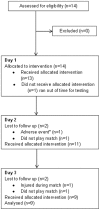The effect of three different (-135°C) whole body cryotherapy exposure durations on elite rugby league players
- PMID: 24489726
- PMCID: PMC3906033
- DOI: 10.1371/journal.pone.0086420
The effect of three different (-135°C) whole body cryotherapy exposure durations on elite rugby league players
Abstract
Background: Whole body cryotherapy (WBC) is the therapeutic application of extreme cold air for a short duration. Minimal evidence is available for determining optimal exposure time.
Purpose: To explore whether the length of WBC exposure induces differential changes in inflammatory markers, tissue oxygenation, skin and core temperature, thermal sensation and comfort.
Method: This study was a randomised cross over design with participants acting as their own control. Fourteen male professional first team super league rugby players were exposed to 1, 2, and 3 minutes of WBC at -135°C. Testing took place the day after a competitive league fixture, each exposure separated by seven days.
Results: No significant changes were found in the inflammatory cytokine interleukin six. Significant reductions (p<0.05) in deoxyhaemoglobin for gastrocnemius and vastus lateralis were found. In vastus lateralis significant reductions (p<0.05) in oxyhaemoglobin and tissue oxygenation index (p<0.05) were demonstrated. Significant reductions (p<0.05) in skin temperature were recorded. No significant changes were recorded in core temperature. Significant reductions (p<0.05) in thermal sensation and comfort were recorded.
Conclusion: Three brief exposures to WBC separated by 1 week are not sufficient to induce physiological changes in IL-6 or core temperature. There are however significant changes in tissue oxyhaemoglobin, deoxyhaemoglobin, tissue oxygenation index, skin temperature and thermal sensation. We conclude that a 2 minute WBC exposure was the optimum exposure length at temperatures of -135°C and could be applied as the basis for future studies.
Conflict of interest statement
Figures




Similar articles
-
Muscle, skin and core temperature after -110°c cold air and 8°c water treatment.PLoS One. 2012;7(11):e48190. doi: 10.1371/journal.pone.0048190. Epub 2012 Nov 6. PLoS One. 2012. PMID: 23139763 Free PMC article. Clinical Trial.
-
Cold Water Mediates Greater Reductions in Limb Blood Flow than Whole Body Cryotherapy.Med Sci Sports Exerc. 2017 Jun;49(6):1252-1260. doi: 10.1249/MSS.0000000000001223. Med Sci Sports Exerc. 2017. PMID: 28141620 Clinical Trial.
-
Thermal sensation and comfort in women exposed repeatedly to whole-body cryotherapy and winter swimming in ice-cold water.Physiol Behav. 2004 Sep 30;82(4):691-5. doi: 10.1016/j.physbeh.2004.06.007. Physiol Behav. 2004. PMID: 15327918 Clinical Trial.
-
Science of rugby league football: a review.J Sports Sci. 2005 Sep;23(9):961-76. doi: 10.1080/02640410400023381. J Sports Sci. 2005. PMID: 16195048 Review.
-
Whole-body cryotherapy in athletes.Sports Med. 2010 Jun 1;40(6):509-17. doi: 10.2165/11531940-000000000-00000. Sports Med. 2010. PMID: 20524715 Review.
Cited by
-
Effect of whole-body cryotherapy versus placebo cryotherapy on joint pain induced by aromatase inhibitors in women with early stage breast cancer: a randomised clinical trial.BMJ Open. 2023 Dec 9;13(12):e071756. doi: 10.1136/bmjopen-2023-071756. BMJ Open. 2023. PMID: 38070928 Free PMC article. Clinical Trial.
-
Optimal duration of whole-body cryostimulation exposure to achieve target skin temperature: influence of body mass index-a randomized cross-over controlled trial.J Physiol Anthropol. 2024 Nov 1;43(1):28. doi: 10.1186/s40101-024-00375-2. J Physiol Anthropol. 2024. PMID: 39482725 Free PMC article. Clinical Trial.
-
Sex and Body Mass Index Differences in Changes in Skin Temperature After Repeated Sessions of Whole-Body Cryostimulation.J Clin Med. 2024 Dec 3;13(23):7365. doi: 10.3390/jcm13237365. J Clin Med. 2024. PMID: 39685822 Free PMC article.
-
Does whole-body cryotherapy improve vertical jump recovery following a high-intensity exercise bout?Open Access J Sports Med. 2015 Feb 24;6:49-54. doi: 10.2147/OAJSM.S70263. eCollection 2015. Open Access J Sports Med. 2015. PMID: 25750548 Free PMC article.
-
Acute physiological responses and muscle recovery in females: a randomised controlled trial of muscle damaging exercise in hypoxia.BMC Sports Sci Med Rehabil. 2024 Mar 22;16(1):70. doi: 10.1186/s13102-024-00861-1. BMC Sports Sci Med Rehabil. 2024. PMID: 38520001 Free PMC article.
References
-
- Costello JT, Algar L, Donnelly A (2012) Effects of whole-body cryotherapy (−110°C) on proprioception and indices of muscle damage. Scand J Med Sci Sports 22: 190–198. - PubMed
-
- Banfi G, Lombardi G, Columbini A, Melegati G (2010) Whole-body cryotherapy in athletes. Sports Med 7: 1–9. - PubMed
-
- Costello JT, McInerney CD, Bleakley C, Selfe J, Donnelly A (2012) The use of thermal imaging in assessing skin temperature following cryotherapy: A review. J Therm Bio 37: 103–110.
Publication types
MeSH terms
Substances
LinkOut - more resources
Full Text Sources
Other Literature Sources

